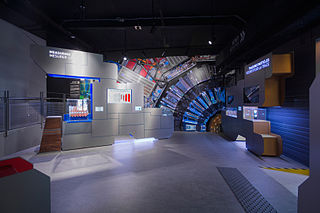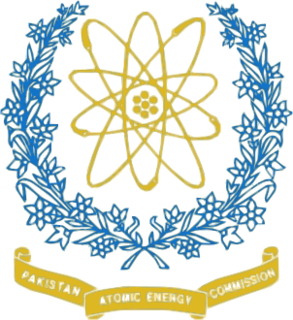
The European Organization for Nuclear Research, known as CERN, is a European research organization that operates the largest particle physics laboratory in the world. Established in 1954, the organization is based in a northwest suburb of Geneva on the Franco–Swiss border and has 23 member states. Israel is the only non-European country granted full membership. CERN is an official United Nations Observer.
Grid computing is the use of widely distributed computer resources to reach a common goal. A computing grid can be thought of as a distributed system with non-interactive workloads that involve many files. Grid computing is distinguished from conventional high-performance computing systems such as cluster computing in that grid computers have each node set to perform a different task/application. Grid computers also tend to be more heterogeneous and geographically dispersed than cluster computers. Although a single grid can be dedicated to a particular application, commonly a grid is used for a variety of purposes. Grids are often constructed with general-purpose grid middleware software libraries. Grid sizes can be quite large.

The Large Hadron Collider (LHC) is the world's largest and highest-energy particle collider. It was built by the European Organization for Nuclear Research (CERN) between 1998 and 2008 in collaboration with over 10,000 scientists and hundreds of universities and laboratories, as well as more than 100 countries. It lies in a tunnel 27 kilometres (17 mi) in circumference and as deep as 175 metres (574 ft) beneath the France–Switzerland border near Geneva.

ATLAS is the largest, general-purpose particle detector experiment at the Large Hadron Collider (LHC), a particle accelerator at CERN in Switzerland. The experiment is designed to take advantage of the unprecedented energy available at the LHC and observe phenomena that involve highly massive particles which were not observable using earlier lower-energy accelerators. ATLAS was one of the two LHC experiments involved in the discovery of the Higgs boson in July 2012. It was also designed to search for evidence of theories of particle physics beyond the Standard Model.

The Compact Linear Collider (CLIC) is a concept for a future linear particle accelerator that aims to explore the next energy frontier. CLIC would collide electrons with positrons and is currently the only mature option for a multi-TeV linear collider. The accelerator would be between 11 and 50 km long, more than ten times longer than the existing Stanford Linear Accelerator (SLAC) in California, USA. CLIC is proposed to be built at CERN, across the border between France and Switzerland near Geneva, with first beams starting by the time the Large Hadron Collider (LHC) has finished operations around 2035.

Microcosm or CERN Museum is an interactive exhibition presenting the work of the CERN particle physics laboratory and its flagship accelerator the Large Hadron Collider (LHC). The current exhibition officially opened in January 2016. Contents were developed by CERN in collaboration with Spanish design team Indissoluble.
National identity is a person's identity or sense of belonging to one or more states or to one or more nations. It is the sense of "a nation as a cohesive whole, as represented by distinctive traditions, culture, and language." National identity may refer to the subjective feeling one shares with a group of people about a nation, regardless of one's legal citizenship status. National identity is viewed in psychological terms as "an awareness of difference", a "feeling and recognition of 'we' and 'they'". National identity also includes the general population and diaspora of multi-ethnic states and societies that have a shared sense of common identity identical to that of a nation while being made up of several component ethnic groups. Hyphenated ethnicities are an example of the confluence of multiple ethnic and national identities within a single person or entity.

ALICE is one of eight detector experiments at the Large Hadron Collider at CERN. The other seven are: ATLAS, CMS, TOTEM, LHCb, LHCf, MoEDAL and FASER.

The Pakistan Atomic Energy Commission (PAEC) ; is a federally funded independent governmental agency, concerned with research and development of nuclear power, promotion of nuclear science, energy conservation and the peaceful usage of nuclear technology.

EGI is a series of efforts to provide access to high-throughput computing resources across Europe using grid computing techniques. The EGI links centres in different European countries to support international research in many scientific disciplines. Following a series of research projects such as DataGrid and Enabling Grids for E-sciencE, the EGI Foundation was formed in 2010 to sustain the services of EGI.
The High Luminosity Large Hadron Collider is an upgrade to the Large Hadron Collider, operated by the European Organization for Nuclear Research (CERN), located at the French-Swiss border near Geneva. From 2011 to 2020, the project was led by Lucio Rossi. In 2020 the lead role was taken up by Oliver Brüning.

The NA58 experiment, or COMPASS is a 60-metre-long fixed-target experiment at the M2 beam line of the SPS at CERN. The experimental hall is located at the CERN North Area, close to the French village of Prévessin-Moëns. The experiment is a two-staged spectrometer with numerous tracking detectors, particle identification and calorimetry. The physics results are extracted by recording and analysing the final states of the scattering processes. The versatile set-up, the use of different targets and particle beams allow the investigation of various processes. The main physics goals are the investigation of the nucleon spin structure and hadron spectroscopy. The collaboration consists of 220 physicists from 13 different countries, involving 28 universities and research institutes.
Techno-nationalism is a way of understanding how technology affects the society and culture of a nation. One common example is the use of technology to advance nationalist agendas, with the goal of promoting connectedness and a stronger national identity. This idea establishes the belief that the success of a nation can be determined by how well that nation innovates and diffuses technology across its people. Technological nationalists believe that the presence of national R&D efforts, and the effectiveness of these efforts, are key drivers to the overall growth, sustainability, and prosperity of a nation.
The Worldwide LHC Computing Grid (WLCG), formerly the LHC Computing Grid (LCG), is an international collaborative project that consists of a grid-based computer network infrastructure incorporating over 170 computing centers in 42 countries, as of 2017. It was designed by CERN to handle the prodigious volume of data produced by Large Hadron Collider (LHC) experiments.

The safety of high energy particle collisions was a topic of widespread discussion and topical interest during the time when the Relativistic Heavy Ion Collider (RHIC) and later the Large Hadron Collider (LHC)—currently the world's largest and most powerful particle accelerator—were being constructed and commissioned. Concerns arose that such high energy experiments—designed to produce novel particles and forms of matter—had the potential to create harmful states of matter or even doomsday scenarios. Claims escalated as commissioning of the LHC drew closer, around 2008–2010. The claimed dangers included the production of stable micro black holes and the creation of hypothetical particles called strangelets, and these questions were explored in the media, on the Internet and at times through the courts.
Science diplomacy is the use of scientific collaborations among nations to address common problems and to build constructive international partnerships. Science diplomacy is a form of new diplomacy and has become an umbrella term to describe a number of formal or informal technical, research-based, academic or engineering exchanges, within the general field of international relations and the emerging field of global policy making.

Sir Tejinder Singh Virdee,, is a Kenyan-born British experimental particle physicist and Professor of Physics at Imperial College London. He is best known for originating the concept of the Compact Muon Solenoid (CMS) with a few other colleagues and has been referred to as one of the 'founding fathers' of the project. CMS is a world-wide collaboration which started in 1991 and now has over 3500 participants from 45 countries.

Peter Jenni, is an experimental particle physicist working at CERN. He is best known as one of the "founding fathers" of the ATLAS experiment at the CERN Large Hadron Collider together with a few other colleagues. He acted as spokesperson of the ATLAS Collaboration until 2009. ATLAS is a world-wide collaboration which started in 1992 involving roughly 3,000 physicists at 183 institutions in 38 countries. Jenni was directly involved in the experimental work leading to the discoveries of the W and Z bosons in the 1980s and the Higgs boson in 2012. He is (co-)author of about 1000 publications in scientific journals.

The Future Circular Collider (FCC) is a proposed post-LHC particle accelerator with an energy significantly above that of previous circular colliders. The FCC project examines scenarios for three different types of particle collisions: hadron collisions in a collider design known as FCC-hh, electron–positron collisions in a collider design known as FCC-ee, and proton–electron collisions in a collider design known as FCC-eh.
Oliver Buchmueller is a scientist and professor of physics at the Faculty of Natural Science, Imperial College London. Buchmueller is presently serving as one of the lead scientists on the CMS experiment at CERN’s LHC, the Principal Investigator of the Atom Interferometer Observatory and Network (AION) and also one of the lead authors at Atomic Experiment for Dark Matter and Gravity Exploration in Space (AEDGE). Previously he has been associated with ALPEH experiment at CERN’s LEP collider and the BaBar experiment at SLAC. Buchmueller was among the group of scientists responsible for the discovery of Higgs Boson particle at the LHC, CERN and later in the scientific exploration to find the traces of dark matter through the LHC.















